
Hand Expressing Breastmilk: the Marmet Technique
Chele Marmet is a mother, pioneering lactation consultant, and the Co-Founder of the Lactation Institute in Los Angeles. She is the creator of the “Marmet technique” of manual expression, the best-known and most widely used manual expression method in the world.
This manual expression technique allows you to express breastmilk in a practical and safe way, pain-free and with no equipment needed, allowing you to express milk anywhere and any time you need it. This technique also helps women to lose their fear of touching and handling their breasts and improves their knowledge of their own breasts and body. It also removes the need to use electric breast pumps, which are not always available because they might be costly or simply because electricity might not be readily available.
The Marmet technique consists of two stages; in the first stage, the mother stimulates her breast to enable the milk ejection reflex, and in the second stage, movements are performed to express the milk. It is important to follow both steps to express milk effectively. As with any technique, it is essential to learn, practice and adapt it to your own individual needs, so don’t worry if you get little milk or find it exhausting the first few times you try it.
Before starting with this technique, remember that breastmilk does not come from the nipple; it only comes out through the nipple. The area you are going to work on is the areola, which is the area where babies put their mouths to express milk.
To avoid hurting yourself, don’t slide your fingers over your skin, and don’t squeeze the areola or nipple, as these movements are ineffective and could be painful.
First stage: stimulation
As mentioned earlier, this stage is very important, especially if you have never done manual extraction before and are not yet experienced in it. If you skip this first part, it is possible that the extraction will not be as effective. Furthermore, this may lead you to make movements that are neither useful nor effective and that could even hurt you.
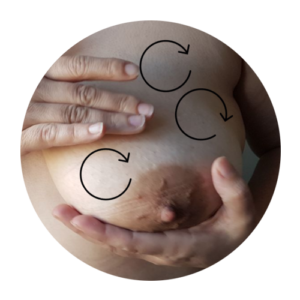
Start by massaging with circular movements with your fingers at a single point, without sliding them over the skin, while pressing your breast towards your ribs. Repeat these movements for a few seconds at each point all over the breast around the areola and towards the nipple. Observe as you touch each section of your breast, and look for areas where you notice any lumps or milk retention. This way, you can detect the differences at the end of the extraction.
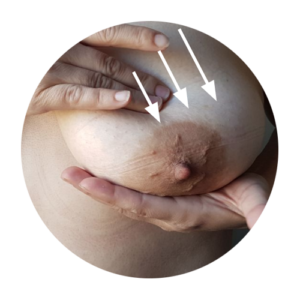
Gently brush without pressing (as if stroking) from the top towards the nipple. This movement will encourage and stimulate the milk let-down reflex.
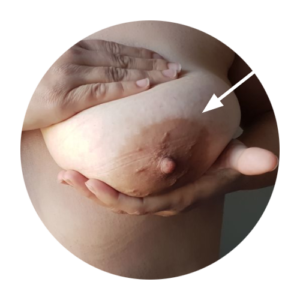
Lean forward and slightly shake your breast; gravity and this movement will help.
Second stage: expressing
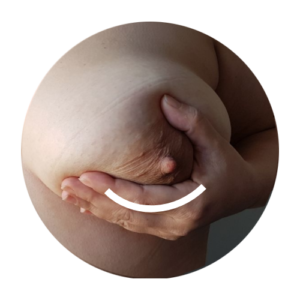
Place your thumb and index finger about 3-4 cm (1 to 1.5 in) behind the nipple (it does not have to be where the end of your areola is, as every areola is different). Make a “C” shape with your hand. You should feel that you are holding your breast with your entire hand.
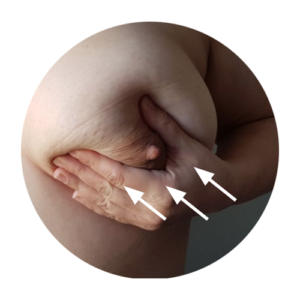
With your fingers, push your breast back towards the ribs. Do not spread your fingers apart or slide them over the skin, but keep your hand in a C-shape.
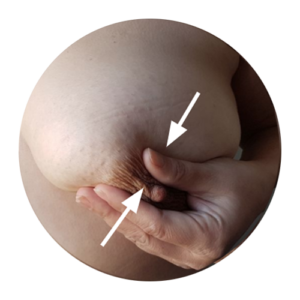
Squeeze your thumb and index finger slightly towards the nipple without letting them slide over the skin. At this point, the first drops of breastmilk should appear on the nipple.
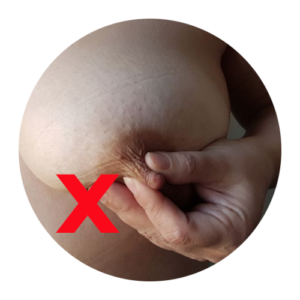
Always avoid sliding your fingers over the skin, and don’t squeeze the areola or nipple, as these movements are not effective and may be painful.
Keep in mind that you should use both hands for each breast and rotate around the breast in different areas until you have covered the entire circle of your breast, as the mammary glands are distributed all over the breast. By doing so, you will be able to express more milk.
If hardly anything comes out the first time, don’t worry. You need to be patient and practice, and try to find the best way for you based on these instructions. Mothers who use the Marmet technique usually adapt their movements to their own breasts and eventually achieve a better and more effective milk extraction. Finally, you can see in this video how the technique is performed.
If you want to know more about expressing breastmilk and how to store it, there are several sections in the LactApp app for more information.
If you need help, our maternity and breastfeeding expert team is available in the Consultation Channel of our LactApp app, free to download for iPhone and Android.